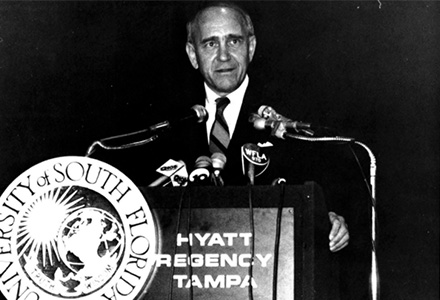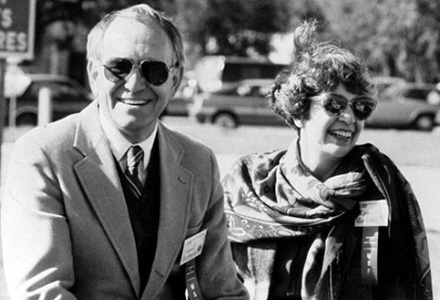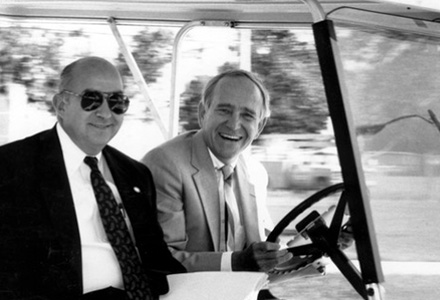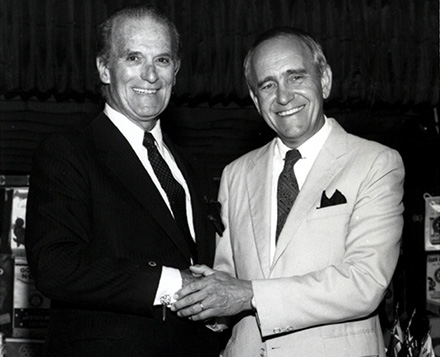By Tom Woolf, University Communications and Marketing

President Borkowski speaks about USF at a press conference at the Hyatt Regency Hotel [Credit: USF Yearbook 1988]
Francis T. Borkowski, the fourth president of the University of South Florida, passed away at the age of 88 on Sunday, Jan. 19, in North Carolina.
Borkowski served as president from 1988 to 1993.
"I first met Frank Borkowski early in his tenure as USF president when he visited me at my law firm to discuss Florida's landscape and his vision for the university's future. I greatly enjoyed working with him to help strengthen USF's reputation across the state," USF President Rhea Law said. "Frank was truly a champion for our students and our university. His influence is a reminder that throughout USF's history, we have continued building on the successes of past champions like him to ensure we keep reaching greater levels of excellence. We are deeply saddened by his passing, and he will be sorely missed."
Borkowski was serving as provost at the University of South Carolina when he was selected from among 146 candidates for the USF presidency.

Francis Borkowski, who took office as the fourth USF President in 1988, is seen with his wife, Kay Borkowski. [Credit: USF Digital Commons]
“It just impressed me as a place that had many opportunities,” Borkowski said of USF during a 2004 oral history interview with the USF Libraries special collections department. “One, to engage the community more and to build on that community relationship. This was a growing part of the country, and here was a university that could help shape the way that growth took place.”
Borkowski and his wife, Kay, also found Tampa and St. Petersburg “to be attractive areas to live.” The couple, both accomplished musicians, also were impressed with the region’s arts community.
During his five-year tenure, USF’s enrollment increased from 30,000 to more than 34,000. Borkowski’s priorities included growing the university’s research enterprise, and research grants increased from $37 million to $60 million. The USF Foundation’s endowment grew from $21 million to $61 million during Borkowski’s presidency.

Charles Reed, the Chancellor for the State University System of Florida, took a golf cart tour of the USF campus with President Francis Borkowski in 1989. [Credit: USF Digital Commons]
Borkowski oversaw the first major fundraising drive in USF history, “Campaign USF,” which raised nearly $120 million by late 1991 – believed to be the most successful effort in the State University System’s history at the time. In addition, he became a key figure in laying the groundwork for USF to form a football program by appointing a group to study its feasibility in 1991. Even as the idea was met with resistance, Borkowski persisted. Though he would leave USF in 1993, two years later the football program was established and went on to become the fastest in the state of Florida to reach 150 wins.
Early in his presidency, Borkowski recognized the importance of USF building bridges to Tampa’s Latino community. At the time, postsecondary degree completion among Hispanic students was low – a fact that impeded the Hispanic community’s economic growth. After listening to concerned leaders, Borkowski created the Latin Community Advisory Council, which still exists today.

President Francis Borkowski and Cesar Gonzmart [Credit: USF Digital Commons]
Additionally, the Latino Scholarship Program was established in 1992 during his presidency. To date, the program has awarded over $5 million in scholarships and supported more than 1,100 participants. His efforts also included arranging for the collection of books, documents, photographs and other items from Centro Asturiano de Tampa to be transferred to the USF Libraries. Centro Asturiano de Tampa, founded in 1902, was one of Tampa’s first Spanish mutual aid societies.
A number of major construction projects began or were completed on the Tampa campus during his presidency, including the Communication and Information Sciences Building and Lifsey House, as well as major renovations to what at the time was known as the student center. The Martin Luther King Jr. Plaza was dedicated during his tenure.
Borkowski also was a strong supporter of USF GraphicStudio, and he invited the studio to install art in the Lifsey House. Artwork from the studio continues to be displayed there.
Borkowski also enjoyed trading places with a USF student for one day each year. In 1988, student Susan Keil became president of the university, while Borkowski attended classes. In a story in USF’s student newspaper, the Oracle, Keil was quoted as telling Borkowski at the end of the day, “President, you can have your headache back now.”
Borkowski left USF in 1993 to become chancellor of Appalachian State University in Boone, North Carolina.
In addition to his wife, Borkowski is survived by their children Stanley Borkowski (Inga), Anne-Marie Scott (Robert) and Christian Borkowski (Karen); and their grandchildren Molly Scott, Nora Scott, Ian Borkowski and Ryan Borkowski. Read his obituary.